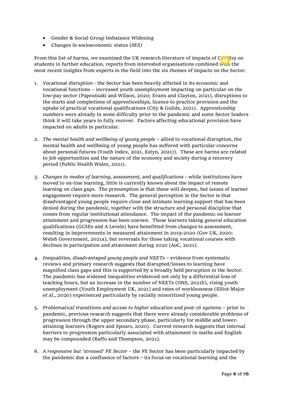
Page 6 of 76
• Gender & Social Group Imbalance Widening
• Changes in socioeconomic status (SES)
From this list of harms, we examined the UK research literature of impacts of Covid19 on
students in further education, reports from interested organisations combined with the
most recent insights from experts in the field into the six themes of impacts on the Sector.
1. Vocational disruption - the Sector has been heavily affected in its economic and
vocational functions - increased youth unemployment impacting on particular on the
low-pay sector (Papoutsaki and Wilson, 2020; Evans and Clayton, 2021), disruptions to
the starts and completions of apprenticeships, licence to practice provision and the
uptake of practical vocational qualifications (City & Guilds, 2021). Apprenticeship
numbers were already in some difficulty prior to the pandemic and some Sector leaders
think it will take years to fully recover. Factors affecting educational provision have
impacted on adults in particular.
2. The mental health and wellbeing of young people - allied to vocational disruption, the
mental health and wellbeing of young people has suffered with particular concerns
about personal futures (Youth Index, 2021, Estyn, 2021)). These are harms are related
to job opportunities and the nature of the economy and society during a recovery
period (Public Health Wales, 2021).
3. Changes to modes of learning, assessment, and qualifications - while institutions have
moved to on-line learning, little is currently known about the impact of remote
learning on class gaps. The presumption is that these will deepen, but issues of learner
engagement require more research. The general perception in the Sector is that
disadvantaged young people require close and intimate learning support that has been
denied during the pandemic, together with the structure and personal discipline that
comes from regular institutional attendance. The impact of the pandemic on learner
attainment and progression has been uneven. Those learners taking general education
qualifications (GCSEs and A Levels) have benefitted from changes to assessment,
resulting in improvements in measured attainment in 2019-2020 (Gov UK, 2020;
Welsh Government, 2021a), but reversals for those taking vocational courses with
declines in participation and attainment during 2020 (AoC, 2021).
4. Inequalities, disadvantaged young people and NEETs - evidence from systematic
reviews and primary research suggests that disrupted/losses to learning have
magnified class gaps and this is supported by a broadly held perception in the Sector.
The pandemic has widened inequalities evidenced not only by a differential loss of
teaching hours, but an increase in the number of NEETs (ONS, 2021b), rising youth
unemployment (Youth Employment UK, 2021) and rates of worklessness (Elliot-Major
et al., 2020) experienced particularly by racially minoritized young people.
5. Problematical transitions and access to higher education and post-16 systems - prior to
pandemic, previous research suggests that there were already considerable problems of
progression through the upper secondary phase, particularly for middle and lowerattaining
learners (Rogers and Spours, 2020). Current research suggests that internal
barriers to progression particularly associated with attainment in maths and English
may be compounded (Raffo and Thompson, 2021).
6. A responsive but 'stressed' FE Sector - the FE Sector has been particularly impacted by
the pandemic due a confluence of factors - its focus on vocational learning and the